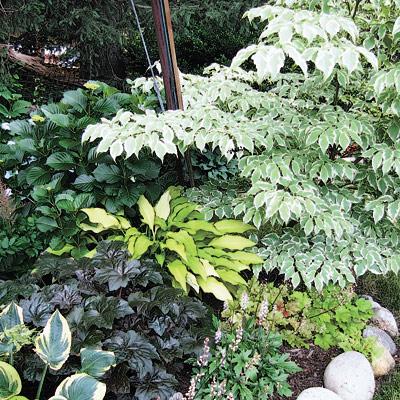Star Gardener: Hosta Seduction

To what can we attribute the enduring popularity of hostas? They can be likened to the Helen of Troy or Cleopatra of the floral world, seducing non-gardening homeowners and casual and obsessed gardeners alike.
All this passion for a plant that can be destroyed by deer, voles, and slugs. In my own garden the voles sometimes get them even when they are sunk into the ground in plastic pots.
So why did I find myself on a recent Saturday morning driving to a meeting of the Tri-State Hosta Society, a chapter of the American Hosta Society, in Northport, north of Exit 51 on the Long Island Expressway? It had to be more than a writer in search of a story.
At least one member came with a spreadsheet detailing her own collection, referring to it intently as we paid homage to the pristine clumps of well-labeled specimens in our hosts’ garden. The thought of voles restrained my bidding during the auction, but the adrenaline rush and lust for the hostas in that garden caused me to make an appointment to visit a few days later Long Island’s Home of Hostas (lihosta.com), a satisfying specialty nursery owned by Mike and Dawn Koller at their house in Medford.
Yes, satisfying because in spite of the odds favoring vole damage, 13 pots proved irresistible and returned with me to East Hampton.
I’ve wanted to share this nursery with you for several years now. The Kollers have established jaw-dropping display beds at the front and side of the house with their collection of about 600 well-labeled hostas. The plants demonstrate their mature sizes and are grown in combinations that make their colors explode. A large sales area is in the rear.
To do justice to the plants at least two trips are needed to explore the display gardens properly. The first to admire individual plants and make notes on which you might want to purchase, and the second to absorb the plant combinations. Last week I arrived with a wish list of plants I had drooled over at the hosta meeting, and yes, Holy Mouse Ears, a variegated miniature sport of the very popular Blue Mouse Ears, and the large, variegated Earth Angel were available.
Miniatures are becoming more and more popular. They are best grown away from the competition and chaos in the shade garden (at least in mine), where they are overwhelmed and easily lost. Miniatures can do well at the front of beds but are more reliably grown in raised beds or troughs. Raised beds are ideal because the plants are closer to eye level for easier viewing, but stay alert to incursions of chipmunks and voles. A terrific idea from the Kollers is planting miniatures as a groundcover under a small Japanese maple in a container. I’m trying an adaptation, growing them under the drip line of a cutleaf Japanese maple in the middle of the lawn.
The United States is the center of hosta breeding. There are thousands of registered cultivars, categorized by size from miniature, small, and medium to large, and by leaf color. But that doesn’t begin to describe them. Leaf texture can be so delicate exposure to sun melts it, or leathery and rumpled enough to resist slugs; it can be glossy or have a matte finish.
Convention has it you don’t grow hostas for their flowers, but that is not completely true. Some are highly fragrant. A few have double flowers. Others are an arresting dark purple. And then there is my favorite hosta of all, the very large, variegated Sagae. Its bud is mesmerizing, looking like a very slowly opening lotus over a period of weeks.
To protect plants from voles many collectors have begun sinking metal mesh baskets in the ground and then potting the hostas in the baskets. A friend who recently visited Tennessee reports gardeners there place hostas in simple terra-cotta pots throughout the beds. In Japan, where land is at a premium, hostas are traditionally grown in containers and displayed near the door. The best protection of all is Little Louie, the Christmas kitten, who seems to be eliminating both moles and voles far better and more safely than rat bait in traps.
That shade garden in Northport deftly demonstrates how to integrate hostas, even a large collection, into the fabric of the design. Hostas and hydrangeas make excellent companions, particularly when matching the shade of green of the hydrangea leaf with that of the hosta. Some of the new heucheras, such as Obsidian, Caramel, and Encore, tiarellas, carexes, and cultivars of Japanese forest grass, Hakonechloa macra, are good combinations with hostas.
Why the passion for hostas? Who knows. But just thinking of them makes their siren song all the sweeter.
